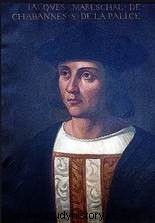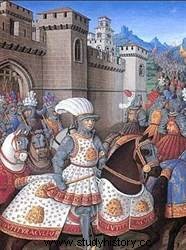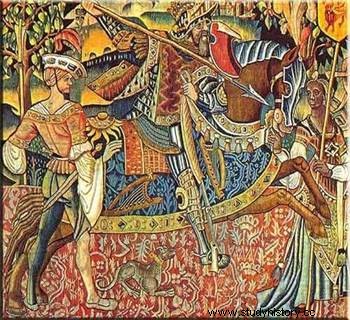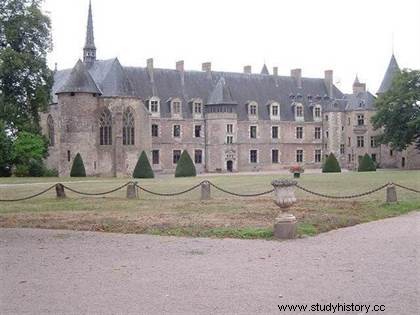 The lord of La Palice distinguished himself during the Battle of Marignan, which earned him the title of Marshal of France in 1515. He gave his name to the famous "lapalissades or “the truth of La Palice”. However, it is not for much, it was enough for him to die on February 24, 1525 at the Battle of Pavia for his soldiers to dedicate a song to him. The original read "alas, if he hadn't died, he would still be envious" which changed to "alas, if he hadn't died, he would still be alive" after an error in reading the 'old French.
The lord of La Palice distinguished himself during the Battle of Marignan, which earned him the title of Marshal of France in 1515. He gave his name to the famous "lapalissades or “the truth of La Palice”. However, it is not for much, it was enough for him to die on February 24, 1525 at the Battle of Pavia for his soldiers to dedicate a song to him. The original read "alas, if he hadn't died, he would still be envious" which changed to "alas, if he hadn't died, he would still be alive" after an error in reading the 'old French.
The life of La Palice
Jacques II de Chabannes nicknamed Jacques de La Palice was born in 1470 in Bourbonnais. His grandfather Jacques I de Chabannes was a companion of Joan of Arc. Noble and great French soldier, La Palice obtains, among others, the titles of lord of La Palice, Pacy, Bort-le-Comte and Héron, then is made Marshal of France. Throughout his military career where he fought in all the Italian wars, he served three kings of France:Charles VIII, Louis XII and François Ier.
 At the age of 15, he entered the service of Charles VIII. Three years later, he participated in the battle of Saint Aubin du Cormier in July 1488, won by French troops against the Duke of Brittany, putting an end to the mad war. He had time to marry Jeanne de Montberon in 1492, before leaving to conquer the Kingdom of Naples in 1494. The same year, he fought in the Duchy of Asti, then the Milanese. He then took part in the capture of Naples in February 1495 and in the battle of Fornoue.
At the age of 15, he entered the service of Charles VIII. Three years later, he participated in the battle of Saint Aubin du Cormier in July 1488, won by French troops against the Duke of Brittany, putting an end to the mad war. He had time to marry Jeanne de Montberon in 1492, before leaving to conquer the Kingdom of Naples in 1494. The same year, he fought in the Duchy of Asti, then the Milanese. He then took part in the capture of Naples in February 1495 and in the battle of Fornoue.
When the king died in 1498, he accompanied Louis XII to Milan, which was taken in October 1499. Supported by his new king, he took several places in 1501, obtaining the title of Viceroy of Abruzzo in 1502, but was taken prisoner by Gonzaga of Cordoba in southern Italy. He was only released two years later, unfortunately the same year his wife disappeared.
The Italian mirage
Between 1507 and 1513, the year the Italian dream ended for Louis XII, La Palice did not stop:very seriously wounded in Genoa, he returned to fight against the Republic of Venice; he is from the siege of Treviso and obtains the command of the French troops in Lombardy. To help Emperor Maximilian I, he laid siege to Venice in 1509. In 1511, he succeeded Charles II of Amboise, Viceroy of Lombardy, as commander of the French troops. Thus, he obtained the highly prized office of Grand Master of France. He gives way to Gaston de Foix Nemours, the king's nephew, and leaves him in command of the army. He assists him and brings help to the Bolognese besieged by the Spaniards. In 1512, he fought in the Battle of Ravenna alongside Bayard and although it was a French victory, Gaston de Foix-Nemours died there.
The Palice thus regains command of the armies. He did not have time to rest:initially sent to the Pyrenees to help the King of Navarre, he had to leave for Artois to face Henry VIII. On August 16, 1513, the "day of the spurs" also called the battle of Guinegatte is fatal for the sieur La Palice, he is wounded and taken prisoner. This defeat, along with that of Navarre in the Pyrenees, marked the end of Louis XII's Italian dream:the Treaty of Dijon was signed in September.
La Palice retired to his home and married Marie de Melun, Lady of Montmirail in February 1514.
The death of La Palice in Pavia, origin of the "lapalissades"
With the accession to the throne of Francis I, the king's friends are gratified; also La Palice loses his office of Grand Master in favor of Gouffier de Boisy, but is raised to the rank of Marshal of France on January 7, 1515. With this new king, La Palice has more functions such as adviser to the king in many treaties as well than being admitted at embassy hearings. This same king also dreams of Italy and the war resumes. The army crosses the passes of Larche and Argentière, enters Piedmont and the vanguard commanded by La Palice surprises the Swiss and the Italians, then takes control of Villefranche.
 He advised the king during the Battle of Marignan and negotiated peace with the Emperor Charles V in Calais during from Camp du Cloth d'Or. He gave good advice during the Battle of Tournai in October 1521. After a stint in Italy to command the main line of the army during the Battle of La Bicoque in 1522, he went to supply Hondarribia in the Pyrenees. François I, having problems with the constable of Bourbon, sent his faithful emissary La Palice to lift the siege of Marseilles at the end of September, then seizing Avignon. La Palice then heads towards Milan with his army.
He advised the king during the Battle of Marignan and negotiated peace with the Emperor Charles V in Calais during from Camp du Cloth d'Or. He gave good advice during the Battle of Tournai in October 1521. After a stint in Italy to command the main line of the army during the Battle of La Bicoque in 1522, he went to supply Hondarribia in the Pyrenees. François I, having problems with the constable of Bourbon, sent his faithful emissary La Palice to lift the siege of Marseilles at the end of September, then seizing Avignon. La Palice then heads towards Milan with his army.
In October 1524, the siege of Pavia began, defended by the Spaniards. This is how the king finds the constable of Bourbon who now joins the army of the emperor. The battle itself took place on February 24 and 25, 1525. The king's advisers debated whether to attack or wait. La Palice is the only one to exhort the king to battle. However, it is necessary to wait until the army is in place, but the king, too impatient to fight it out, cannot help sounding the charge. The knights stopped by the opposing arquebusiers dismount and must fight like this. La Palice is taken prisoner by an Italian captain, but killed by a Spanish arquebusier. His faithful soldiers then write a song in his honor to celebrate his courage, of which here is a stanza:
“Alas, La Palice is dead,
Died before Pavia;
Alas, if he hadn't died,
He would still be envious".
And for a mistake in French, the "truth and nutshell" was born...
the castle of La Palice
Jacques I de Chabannes, the grandfather, bought the feudal design part in 1430. Jacques II, the grandson, had the Renaissance part built at the beginning of the 16th century, with the famous pink bricks. This wing connects the fortified castle and the Gothic-style chapel built around 1460. The chapel served as a tomb for the members of the family. In 1530, Marie de Melun had the tomb of La Palice built in this chapel. Unfortunately, like many funerary monuments, it will be ransacked during the Revolution. In 1830, Baron de Montfaucon discovered some pieces of the tomb, bought them and bequeathed them to the Calvet museum in Avignon.
 During the visit of the castle, we discover the furnished rooms housing many historical souvenirs, the hangings of the 15th century , the coffered ceilings enhanced with gold and colors. Historical monument since July 1998, the park dates from the beginning of the 17th century. It consists of a concierge, ponds, a garden with a bridge. During the walk, you can see the old stables and the riding school.
During the visit of the castle, we discover the furnished rooms housing many historical souvenirs, the hangings of the 15th century , the coffered ceilings enhanced with gold and colors. Historical monument since July 1998, the park dates from the beginning of the 17th century. It consists of a concierge, ponds, a garden with a bridge. During the walk, you can see the old stables and the riding school.
Thank you Mr. de La Palice for making us smile with the "truths of the tongue" for more than 500 years! If you hadn't been born on a fine day in 1470, we wouldn't be talking about you!
Bibliography
- Life, Death and Transfiguration of the Lord of La Palice - Dante Zanetti
- Francis I and the Renaissance - Gonzague Saint Bris
- Curiosities and enigmas of the History of France – JP Colignon
